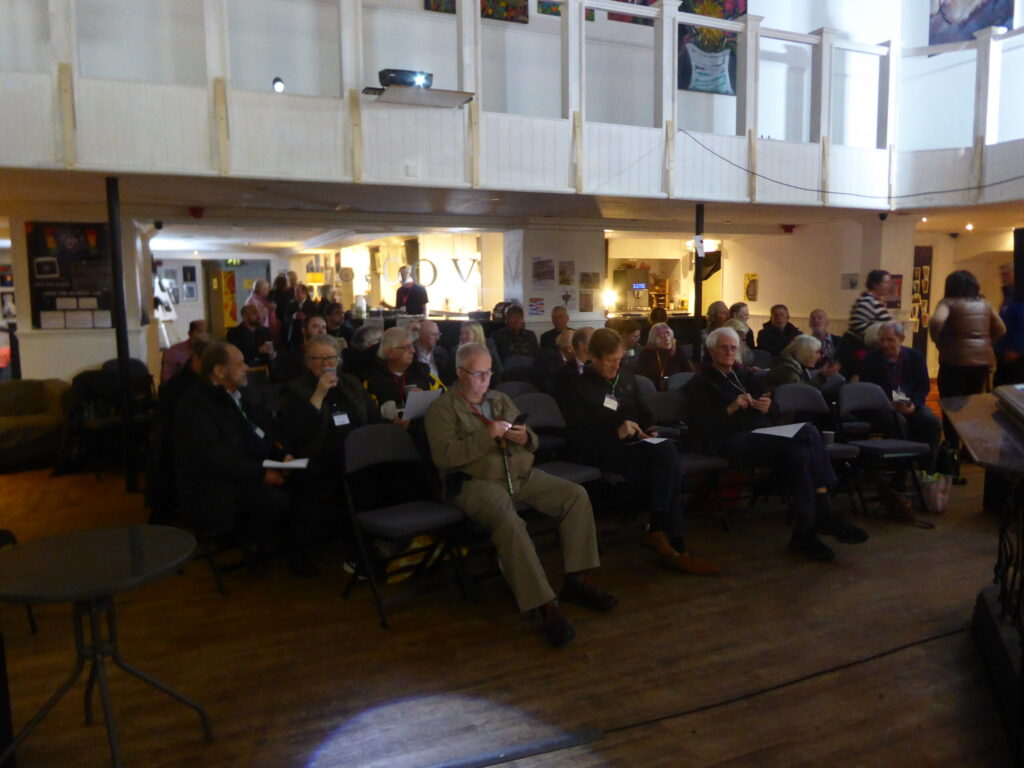
More than fifty people attended the Coventry Society’s third heritage conference at the end of October.
The conference was held at the Litten Tree Building in Warwick Road on Saturday 28th October. The main theme of the meeting was Coventry’s hidden heritage.
The meeting started with good look at the Litten Tree Building itself, which is shortly to be demolished to make way for City Centre South. Alan Denyer told us about the philosophy of the community arts space which houses over eighty works of art by local Coventry artists.
Mark Cook told us the fascinating history of the building, which started life as the Rover Showroom before becoming the place where Donald Gibson redesigned the city centre. It was also the wartime ration office. In later life it was a furniture showroom and many people will remember Intershop before the buildings last use as a pub.
Peter Walters updated the audience on the plans for City Centre South, which have been delayed due to changes in the Building Regulations arising from the Grenfell Tower disaster.
CovSoc committee member Aaron Law told us about the public art that will need to be moved to make way for City Centre South. He showed us recent images by Historic England of the Mitchell mural in Hertford House. It is hoped that this mural can be moved, but as it is constructed of chicken wire and plaster it might be difficult. However, a digital scan has been taken, so that it can be reconstructed if relocation is not possible.
In a return visit to Coventry, Charlotte Ridpath told us some fascinating stories about the River Sherbourne and its mills. It is quite unusual for a Wildlife Trust to get involved in the heritage and cultural sides of a wildlife project and we are very fortunate to have the Sherbourne Valley Project in the city.
In the afternoon we had a series of short presentations by local community groups.
Paul O’Donnell told us about the Museum of Me – a portable museum structure which is used to celebrate the lives of ordinary people in the city. Over the past year it has celebrated the lives of twenty Coventry citizens of all nationalities.
Peter Elias of the Friends of Spencer Park gave us a progress report on the restoration of the pavilion. The designs have been completed and a planning application is currently being considered. Fundraising is going well.
Charlotte Stranks, the City’s Conservation Officer, gave us an update on the restoration of Stoney Road Gardens. A management plan is now in place and Historic England has offered grants to restore three of the summer houses.
Sabine Coady-Schaeblitz from Coventry University told us about an international student workshop that had been held at the Architecture School to look at ideas for the future of Whitefriars Monastery. The building is currently the repository of items from the Herbert Gallery’s collection. As this will be moving into the Ikea Building, it is a good time to be giving thought to the future of Whitefriars.
Mark Johnson told us about the hidden history of Coventry’s Jewish community over the past centuries and particularly its Jewish Watchmakers. There is an exhibition in the Herbert Gallery and Mark has recently published a book on the subject, which is available at the Herbert or online.
Victor Riley paid a return visit to the conference, having told our first conference about his plans to create the Riley archive. That is now fully operational at the Canal Basin, displaying documents and artifacts about the Riley Company, including a rare Riley bicycle. Victor told us that school visits were inspiring young girls to take an interest in mechanical engineering.
Pierre Botcherby told us about Warwick Modern Records Centre at the University library which is celebrating its 50th anniversary this year. The centre houses a wide range of records from the trade union movement and industrial relations history, as well as the University’s own records and local community groups. The centre is open to the public on weekdays between 9 a.m. – 5 p.m.
Matt Parker-Wooding, the city’s Archaeologist and Historic Records Officer told us about recent archaeological findings around the city. Charterhouse continues to provide interesting finds, but it has not proved possible to identify the site of St. Anne’s Chapel. Archaeology associated with the development on the city’s former greenbelt in Eastern Green and Keresley has revealed Iron Age field systems and Bronze Age activity. The dig on the site of the Black Horse pub at Spon End revealed the foundations of stone and timber houses fronting Spon End, but no evidence of a manor house.
In the future, it is hoped that digs associated with the development on Bishop Street, opposite the Old Grammar School, Palmer Lane and City Centre South will produce some interesting results.
Finally, Tarla Patel, told us about her late father Masterji and his legacy for the city and the country. Maganbhai Patel was a school teacher in India and was called Master by his friends when he opened his photo studio in Stoney Stanton Road. Ji is a designation of respect. Masterji was a photographer with a career spanning seven decades. His photographs and portraits taken between the 1950s and the 2000s, chart the life and history of the South Asian community in Coventry and the West Midlands.
The Masterji exhibition at the Box in Fargo Village was one of the more positive things to come out of City of Culture but unfortunately Masterji died shortly afterwards. Tarla has continued to promote his work and an exhibition was held at Compton Verney recently.
The Coventry Society would like to record its thanks to all the speakers and people who helped organise the event and the participants who came along to listen and share their thoughts. We will be producing a full record of the conference in due course.
